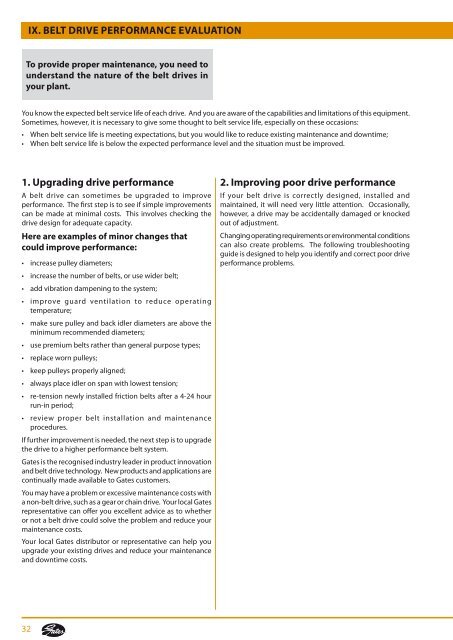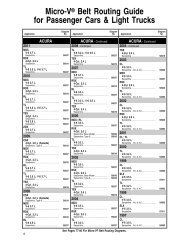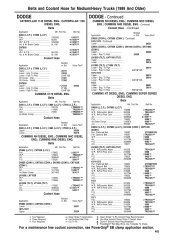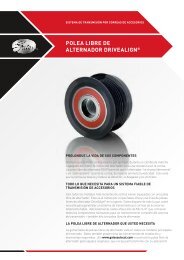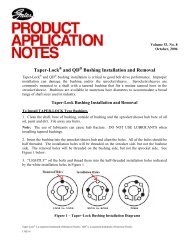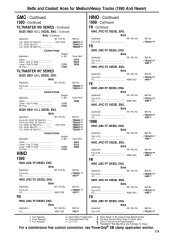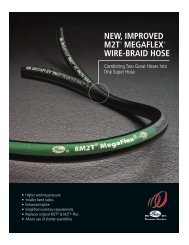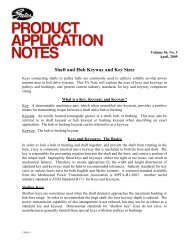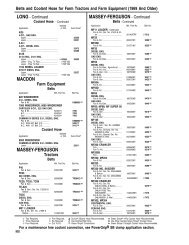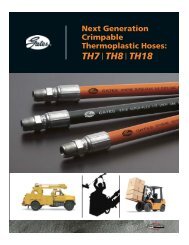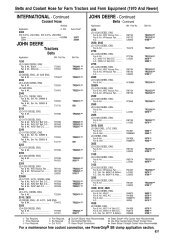industrial belt and drive preventive maintenance - Gates Corporation
industrial belt and drive preventive maintenance - Gates Corporation
industrial belt and drive preventive maintenance - Gates Corporation
- No tags were found...
Create successful ePaper yourself
Turn your PDF publications into a flip-book with our unique Google optimized e-Paper software.
iX. Belt <strong>drive</strong> performance evaluationTo provide proper <strong>maintenance</strong>, you need tounderst<strong>and</strong> the nature of the <strong>belt</strong> <strong>drive</strong>s inyour plant.You know the expected <strong>belt</strong> service life of each <strong>drive</strong>. And you are aware of the capabilities <strong>and</strong> limitations of this equipment.Sometimes, however, it is necessary to give some thought to <strong>belt</strong> service life, especially on these occasions:• When <strong>belt</strong> service life is meeting expectations, but you would like to reduce existing <strong>maintenance</strong> <strong>and</strong> downtime;• When <strong>belt</strong> service life is below the expected performance level <strong>and</strong> the situation must be improved.1. Upgrading <strong>drive</strong> performanceA <strong>belt</strong> <strong>drive</strong> can sometimes be upgraded to improveperformance. The first step is to see if simple improvementscan be made at minimal costs. This involves checking the<strong>drive</strong> design for adequate capacity.Here are examples of minor changes thatcould improve performance:• increase pulley diameters;• increase the number of <strong>belt</strong>s, or use wider <strong>belt</strong>;• add vibration dampening to the system;• improve guard ventilation to reduce operatingtemperature;• make sure pulley <strong>and</strong> back idler diameters are above theminimum recommended diameters;• use premium <strong>belt</strong>s rather than general purpose types;• replace worn pulleys;• keep pulleys properly aligned;• always place idler on span with lowest tension;• re-tension newly installed friction <strong>belt</strong>s after a 4-24 hourrun-in period;• review proper <strong>belt</strong> installation <strong>and</strong> <strong>maintenance</strong>procedures.If further improvement is needed, the next step is to upgradethe <strong>drive</strong> to a higher performance <strong>belt</strong> system.<strong>Gates</strong> is the recognised industry leader in product innovation<strong>and</strong> <strong>belt</strong> <strong>drive</strong> technology. New products <strong>and</strong> applications arecontinually made available to <strong>Gates</strong> customers.You may have a problem or excessive <strong>maintenance</strong> costs witha non-<strong>belt</strong> <strong>drive</strong>, such as a gear or chain <strong>drive</strong>. Your local <strong>Gates</strong>representative can offer you excellent advice as to whetheror not a <strong>belt</strong> <strong>drive</strong> could solve the problem <strong>and</strong> reduce your<strong>maintenance</strong> costs.Your local <strong>Gates</strong> distributor or representative can help youupgrade your existing <strong>drive</strong>s <strong>and</strong> reduce your <strong>maintenance</strong><strong>and</strong> downtime costs.2. Improving poor <strong>drive</strong> performanceIf your <strong>belt</strong> <strong>drive</strong> is correctly designed, installed <strong>and</strong>maintained, it will need very little attention. Occasionally,however, a <strong>drive</strong> may be accidentally damaged or knockedout of adjustment.Changing operating requirements or environmental conditionscan also create problems. The following troubleshootingguide is designed to help you identify <strong>and</strong> correct poor <strong>drive</strong>performance problems.32


